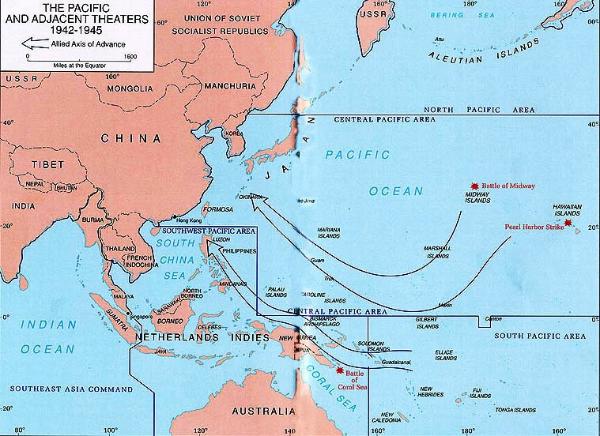Radioman: An Eyewitness Account of Pearl Harbor and World War II in the Pacific Chapter 10. "The Submarine" Bonus Photos--not among the 42 included in the book |
Above map illustrates Radioman, Chapter 10, ("The Submarine"), page 77--and subsequent Chapters 11-20.
Source of Map: Center for Military History, US Army
Source of Map: Center for Military History, US Army
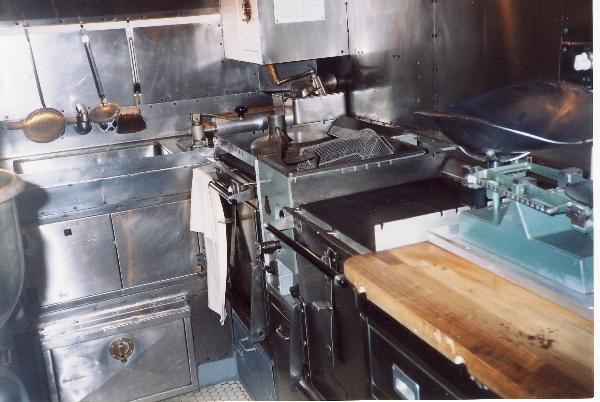
Meals for Dolphin's (SS-169) crew were prepared in a galley similar to that section of the restored World War II
submarine Bowfin (SS-287) on display at the USS Bowfin Submarine Museum and Park, Pearl Harbor, Hawaii, 2003.
Above photo illustrates Radioman, Chapter 10 ("The Submarine"), page 78
Source of Photo: Ted and Marie Wigton Collection
submarine Bowfin (SS-287) on display at the USS Bowfin Submarine Museum and Park, Pearl Harbor, Hawaii, 2003.
Above photo illustrates Radioman, Chapter 10 ("The Submarine"), page 78
Source of Photo: Ted and Marie Wigton Collection

Heavy ceramic dishes minimized sliding on WWII era submarine galley tables, as shown above inside
Bowfin (SS-287), on display at USS Bowfin Submarine Museum and Park, Pearl Harbor, Hawaii, 2003.
Above photo illustrates Radioman, Chapter 10 ("The Submarine"), page 78
Source of Photo: Ted and Marie Wigton Collection
Bowfin (SS-287), on display at USS Bowfin Submarine Museum and Park, Pearl Harbor, Hawaii, 2003.
Above photo illustrates Radioman, Chapter 10 ("The Submarine"), page 78
Source of Photo: Ted and Marie Wigton Collection
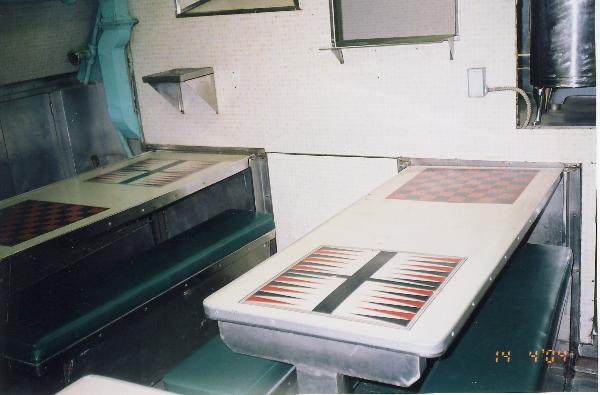
Between meals, the four tables in the submarine's galley area serve as game tables for acey-deucey,
checkers, and chess. (This photo was taken inside the restored WWII submarine Cavalla (SS-244), on
display at Seawolf Park, Galveston, Texas, in 2004.)
Above photo illustrates Radioman, Chapter 10 ("The Submarine"), page 79
Source of Photo: Ray Daves Collection
checkers, and chess. (This photo was taken inside the restored WWII submarine Cavalla (SS-244), on
display at Seawolf Park, Galveston, Texas, in 2004.)
Above photo illustrates Radioman, Chapter 10 ("The Submarine"), page 79
Source of Photo: Ray Daves Collection

Dolphin (SS-169), above, like all other WWII-era submarines, used diesel power when on the surface.
(Dolphin's surface speed of about 17 knots dropped to 8 knots when submerged and moving under battery power.)
Above photo illustrates Radioman, Chapter 10 ("The Submarine"), page 79
Source of photo: U.S. Naval Historical Center, # NH 54542
(Dolphin's surface speed of about 17 knots dropped to 8 knots when submerged and moving under battery power.)
Above photo illustrates Radioman, Chapter 10 ("The Submarine"), page 79
Source of photo: U.S. Naval Historical Center, # NH 54542

The sleeping compartment for enlisted men on World War II-era submarines consisted of tiers of bunks
(tilted up when not in use) on both sides of a narrow passageway.
(This photo was taken inside the restored WWII submarine Cavalla (SS-244), on display at Seawolf Park,
Galveston, Texas, 2004.)
Above photo illustrates Radioman, Chapter 10 ("The Submarine"), page 80
Source of Photo: Ray Daves Collection
(tilted up when not in use) on both sides of a narrow passageway.
(This photo was taken inside the restored WWII submarine Cavalla (SS-244), on display at Seawolf Park,
Galveston, Texas, 2004.)
Above photo illustrates Radioman, Chapter 10 ("The Submarine"), page 80
Source of Photo: Ray Daves Collection
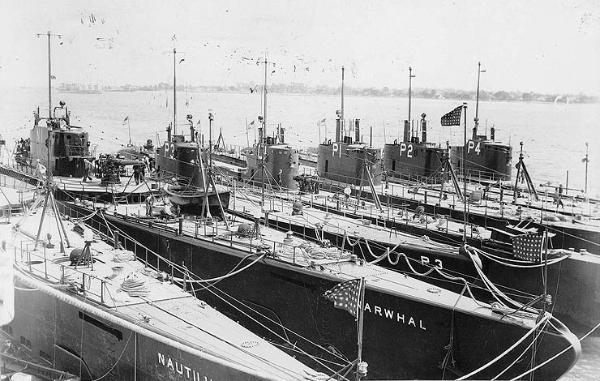
Dolphin was one of 27 submarines of varying lengths in the Pacific Fleet in 1941. The seven shown here are,
from left, Nautilus (SS-168), Narwhal (SS-167), Shark (SS-174, marked P3), Dolphin (SS-169, marked D1),
Porpoise (SS-172, marked P1), Pike (SS-173, marked P2), Tarpon (SS-175, marked P4).
Above photo illustrates Radioman, Chapter 10 ("The Submarine"), page 80
Source of Photo: Naval Historical Center, # NH 3036
from left, Nautilus (SS-168), Narwhal (SS-167), Shark (SS-174, marked P3), Dolphin (SS-169, marked D1),
Porpoise (SS-172, marked P1), Pike (SS-173, marked P2), Tarpon (SS-175, marked P4).
Above photo illustrates Radioman, Chapter 10 ("The Submarine"), page 80
Source of Photo: Naval Historical Center, # NH 3036

The fathometer dial indicates the submarine's submerged depth, as measured in fathoms. (A fathom is equal
to 6 feet.) This photo was taken inside the WWII-era submarine Bowfin (SS-287), USS Bowfin Submarine
Museum and Park, Pearl Harbor, Hawaii, in 2003.
Above photo illustrates Radioman, Chapter 10 ("The Submarine"), page 80
Source of Photo: Ted and Marie Wigton Collection
to 6 feet.) This photo was taken inside the WWII-era submarine Bowfin (SS-287), USS Bowfin Submarine
Museum and Park, Pearl Harbor, Hawaii, in 2003.
Above photo illustrates Radioman, Chapter 10 ("The Submarine"), page 80
Source of Photo: Ted and Marie Wigton Collection
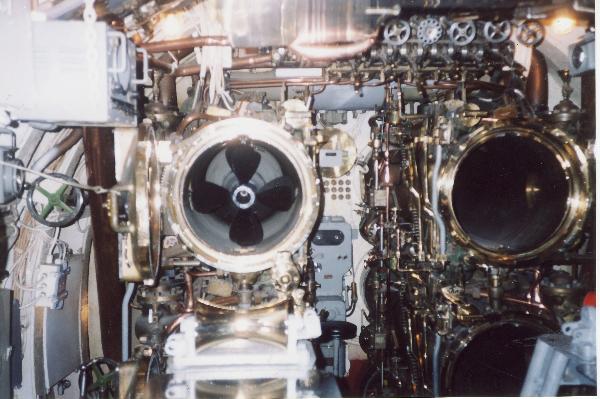
The torpedo tube at left is loaded and ready to fire. (This photo was taken inside the WWII-era submarine
Bowfin (SS-287), on display at USS Bowfin Submarine Museum and Park, Pearl Harbor, Hawaii, in 2003.)
Above photo illustrates Radioman, Chapter 10 ("The Submarine"), page 82
Source of Photo: Ted and Marie Wigton Collection
Bowfin (SS-287), on display at USS Bowfin Submarine Museum and Park, Pearl Harbor, Hawaii, in 2003.)
Above photo illustrates Radioman, Chapter 10 ("The Submarine"), page 82
Source of Photo: Ted and Marie Wigton Collection
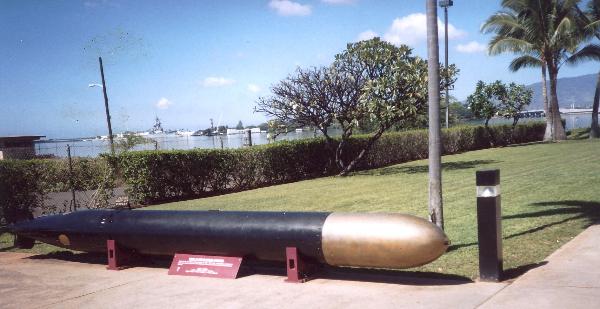
The 18' torpedoes carried by US submarines during World War II were designed to explode on contact with
the targeted enemy ship. (Photo was taken at the USS Bowfin Submarine Museum and Park, Pearl
Harbor, Hawaii, in 2003.)
Above photo illustrates Radioman, Chapter 10 ("The Submarine"), page 82
Source of Photo: Ted and Marie Wigton Collection
the targeted enemy ship. (Photo was taken at the USS Bowfin Submarine Museum and Park, Pearl
Harbor, Hawaii, in 2003.)
Above photo illustrates Radioman, Chapter 10 ("The Submarine"), page 82
Source of Photo: Ted and Marie Wigton Collection
